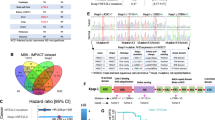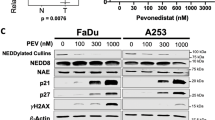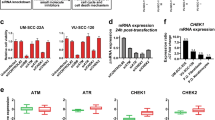Abstract
Although surgery and radiotherapy have been the standard treatment modalities for head and neck squamous cell carcinoma (HNSCC), the integration of cisplatin (CDDP)-based therapy has led to improvements in local and regional control of disease for patients. However, many trials show that only 10–20% of patients benefit from this treatment intensification, which can result in profound treatment-associated morbidity and mortality. Moreover, the marginal survival improvement suggests that CDDP resistance is an innate characteristic of HNSCC. To elucidate the biological mechanisms underpinning CDDP resistance in HNSCC, we utilized an experimental model of CDDP resistance in this disease. We first observed significant enhancements in local tumor growth and metastasis, as well as adverse survival, in CDDP-resistant (CR) tumors compared with sensitive tumors. To elucidate the molecular mechanisms of this phenotype, we undertook a systems biology-based approach utilizing high-throughput PCR arrays, and we identified a significant suppression of KiSS1 mRNA and protein expression in the CR cells, but no significant regions of genomic loss with array comparative genomic hybridization. Genetic suppression of KiSS1 in CDDP-sensitive cell lines rendered them CR, an observation that was mechanistically linked to alterations in glutathione S-transferase-π expression and function. We next confirmed that, in human HNSCC tumors, loss of KiSS1 expression was associated with metastatic human HNSCC tumors compared with non-metastatic tumors. Genetic reconstitution of KiSS1 in CR cells abrogated cellular migration and induced CDDP sensitivity. To confirm these findings in a murine model, either CR or KiSS1-transfected CR cells were studied in an orthotopic model of HNSCC, or survival studies revealed significant improvement in survival of the mice bearing CR-KiSS1 tumors. Mechanistically, alterations in apoptotic pathways and CDDP metabolism contributed to KiSS1-associated chemotherapy sensitization. These studies provided further direct evidence for the role of KiSS1 loss in biologically aggressive HNSCC and suggest potential targets for therapy in CR cancers.
This is a preview of subscription content, access via your institution
Access options
Subscribe to this journal
Receive 50 print issues and online access
$259.00 per year
only $5.18 per issue
Buy this article
- Purchase on Springer Link
- Instant access to full article PDF
Prices may be subject to local taxes which are calculated during checkout





Similar content being viewed by others
References
Antoun G, Baylin SB, Ali-Osman F . (2000). DNA methyltransferase levels and altered CpG methylation in the total genome and in the GSTP1 gene in human glioma cells transfected with sense and antisense DNA methyltransferase cDNA. J Cell Biochem 77: 372–381.
Arai T, Yasuda Y, Takaya T, Hayakawa K, Toshima S, Shibuya C et al. (2000). Immunohistochemical expression of glutathione transferase-pi in untreated primary non-small-cell lung cancer. Cancer Detect Prev 24: 252–257.
Bai F, Nakanishi Y, Kawasaki M, Takayama K, Yatsunami J, Pei XH et al. (1996). Immunohistochemical expression of glutathione S-transferase-Pi can predict chemotherapy response in patients with nonsmall cell lung carcinoma. Cancer 78: 416–421.
Chanvorachote P, Nimmannit U, Stehlik C, Wang L, Jiang BH, Ongpipatanakul B et al. (2006). Nitric oxide regulates cell sensitivity to cisplatin-induced apoptosis through S-nitrosylation and inhibition of Bcl-2 ubiquitination. Cancer Res 66: 6353–6360.
Cho S-G, Yi Z, Pang X, Yi T, Wang Y, Luo J et al. (2009). Kisspeptin-10, a KISS1-derived decapeptide, inhibits tumor angiogenesis by suppressing Sp1-mediated VEGF expression and FAK/Rho GTPase activation. Cancer Res 69: 7062–7070.
Cooper JS, Pajak TF, Forastiere AA, Jacobs J, Campbell BH, Saxman SB et al. (2004). Postoperative concurrent radiotherapy and chemotherapy for high-risk squamous-cell carcinoma of the head and neck. N Engl J Med 350: 1937–1944.
Cullen KJ, Newkirk KA, Schumaker LM, Aldosari N, Rone JD, Haddad BR . (2003). Glutathione S-transferase pi amplification is associated with cisplatin resistance in head and neck squamous cell carcinoma cell lines and primary tumors. Cancer Res 63: 8097–8102.
Di Pietro G, Magno LA, Rios-Santos F . (2010). Glutathione S-transferases: an overview in cancer research. Expert Opin Drug Metab Toxicol 6: 153–170.
Fong PC, Boss DS, Yap TA, Tutt A, Wu P, Mergui-Roelvink M et al. (2009). Inhibition of poly(ADP-ribose) polymerase in tumors from BRCA mutation carriers. N Engl J Med 361: 123–134.
Forastiere AA, Goepfert H, Maor M, Pajak TF, Weber R, Morrison W et al. (2003). Concurrent chemotherapy and radiotherapy for organ preservation in advanced laryngeal cancer. N Engl J Med 349: 2091–2098.
Ganjavi H, Gee M, Narendran A, Freedman MH, Malkin D . (2005). Adenovirus-mediated p53 gene therapy in pediatric soft-tissue sarcoma cell lines: sensitization to cisplatin and doxorubicin. Cancer Gene Ther 12: 397–406.
Goldberg SF, Miele ME, Hatta N, Takata M, Paquette-Straub C, Freedman LP et al. (2003). Melanoma metastasis suppression by chromosome 6: evidence for a pathway regulated by CRSP3 and TXNIP. Cancer Res 63: 432–440.
Hamaguchi K, Godwin AK, Yakushiji M, O'Dwyer PJ, Ozols RF, Hamilton TC . (1993). Cross-resistance to diverse drugs is associated with primary cisplatin resistance in ovarian cancer cell lines. Cancer Res 53: 5225–5232.
Hu H, Jiang C, Ip C, Rustum YM, La J . (2005). Methylseleninic acid potentiates apoptosis induced by chemotherapeutic drugs in androgen-independent prostate cancer cells. Clin Cancer Res 11: 2379–2388.
Jiang Y, Berk M, Singh LS, Tan H, Yin L, Powell C et al. (2005). KiSS1 suppresses metastasis in human ovarian cancer via inhibition of protein kinase C alpha. Clin Exp Metast 22: 369–376.
Karin M, Lin A . (2002). NF-[kappa]B at the crossroads of life and death. Nat Immunol 3: 221–227.
Kelland L . (2007). The resurgence of platinum-based cancer chemotherapy. Nat Rev Cancer 7: 573–584.
Khan K, Araki K, Wang D, Li G, Li X, Zhang J et al. (2010). Head and neck cancer radiosensitization by the novel poly(ADP-ribose) polymerase inhibitor GPI-15427. Head Neck 32: 381–391.
Kigawa J, Terakawa N . (2000). Adenovirus-mediated transfer of a p53 gene in ovarian cancer. Adv Exp Med Biol 465: 207–214.
Kim SJ, Kang HS, Jung SY, Min SY, Lee S, Kim SW et al. (2010). Methylation patterns of genes coding for drug-metabolizing enzymes in tamoxifen-resistant breast cancer tissues. J Mol Med 88: 1123–1131.
Kupferman ME, Jayakumar A, Zhou G, Xie T, Dakak-Yazici Y, Zhao M et al. (2009). Therapeutic suppression of constitutive and inducible JAK\STAT activation in head and neck squamous cell carcinoma. J Exp Ther Oncol 8: 117–127.
Kupferman ME, Jiffar T, El-Naggar A, Yilmaz T, Zhou G, Xie T et al. (2010). TrkB induces EMT and has a key role in invasion of head and neck squamous cell carcinoma. Oncogene 29: 2047–2059.
Lee JH, Welch DR . (1997). Suppression of metastasis in human breast carcinoma MDA-MB-435 cells after transfection with the metastasis suppressor gene, KiSS-1. Cancer Res 57: 2384–2387.
Li X, Stark GR . (2002). NF[kappa]B-dependent signaling pathways. Exp Hematol 30: 285–296.
Liang C-C, Park AY, Guan J-L . (2007). In vitro scratch assay: a convenient and inexpensive method for analysis of cell migration in vitro. Nat Protocols 2: 329–333.
Liu L-Z, Zhou X-D, Qian G, Shi X, Fang J, Jiang B-H . (2007). AKT1 amplification regulates cisplatin resistance in human lung cancer cells through the mammalian target of rapamycin/p70s6k1pathway. Cancer Res 67: 6325–6332.
Lo HW, Stephenson L, Cao X, Milas M, Pollock R, Ali-Osman F . (2008). Identification and functional characterization of the human glutathione S-transferase P1 gene as a novel transcriptional target of the p53 tumor suppressor gene. Mol Cancer Res 6: 843–850.
Marot D, Bieche I, Aumas C, Esselin S, Bouquet C, Vacher S et al. (2007). High tumoral levels of Kiss1 and G-protein-coupled receptor 54 expression are correlated with poor prognosis of estrogen receptor-positive breast tumors. Endocr Relat Cancer 14: 691–702.
Masanek U, Stammler G, Volm M . (1997). Messenger RNA expression of resistance proteins and related factors in human ovarian carcinoma cell lines resistant to doxorubicin, taxol and cisplatin. Anticancer Drugs 8: 189–198.
Michaud WA, Nichols AC, Mroz EA, Faquin WC, Clark JR, Begum S et al. (2009). Bcl-2 blocks cisplatin-induced apoptosis and predicts poor outcome following chemoradiation treatment in advanced oropharyngeal squamous cell carcinoma. Clin Cancer Res 15: 1645–1654.
Mitchell DC, Stafford LJ, Li D, Bar-Eli M, Liu M . (2007). Transcriptional regulation of KiSS-1 gene expression in metastatic melanoma by specificity protein-1 and its coactivator DRIP-130. Oncogene 26: 1739–1747.
Moffat GJ, McLaren AW, Wolf CR . (1996). Functional characterization of the transcription silencer element located within the human Pi class glutathione S-transferase promoter. J Biol Chem 271: 20740–20747.
Morceau F, Duvoix A, Delhalle S, Schnekenburger M, Dicato M, Diederich M . (2004). Regulation of glutathione S-transferase P1-1 gene expression by NF-kappaB in tumor necrosis factor alpha-treated K562 leukemia cells. Biochem Pharmacol 67: 1227–1238.
Nash KT, Phadke PA, Navenot J-M, Hurst DR, Accavitti-Loper MA, Sztul E et al. (2007). Requirement of KISS1 secretion for multiple organ metastasis suppression and maintenance of tumor dormancy. J Natl Cancer Inst 99: 309–321.
Nash KT, Welch DR . (2006). The KISS1 metastasis suppressor: mechanistic insights and clinical utility. Front Biosci 11: 647–659.
Navenot J-M, Fujii N, Peiper SC . (2009a). Activation of Rho and Rho-associated kinase by GPR54 and KiSS1 metastasis suppressor gene product induces changes of cell morphology and contributes to apoptosis. Mol Pharmacol 75: 1300–1306.
Navenot J-M, Fujii N, Peiper SC . (2009b). KiSS1 metastasis suppressor gene product induces suppression of tyrosine kinase receptor signaling to akt, tumor necrosis factor family ligand expression, and apoptosis. Mol Pharmacol 75: 1074–1083.
Niedner H, Christen R, Lin X, Kondo A, Howell SB . (2001). Identification of genes that mediate sensitivity to cisplatin. Mol Pharmacol 60: 1153–1160.
O'Donnell RK, Kupferman M, Wei SJ, Singhal S, Weber R, O'Malley B et al. (2005). Gene expression signature predicts lymphatic metastasis in squamous cell carcinoma of the oral cavity. Oncogene 24: 1244–1251.
Ohtaki T, Shintani Y, Honda S, Matsumoto H, Hori A, Kanehashi K et al. (2001). Metastasis suppressor gene KiSS-1 encodes peptide ligand of a G-protein-coupled receptor. Nature 411: 613–617.
Rouleau M, Patel A, Hendzel MJ, Kaufmann SH, Poirier GG . (2010). PARP inhibition: PARP1 and beyond. Nat Rev Cancer 10: 293–301.
Soussi T . (2007). p53 alterations in human cancer: more questions than answers. Oncogene 26: 2145–2156.
Soussi T, Wiman KG . (2007). Shaping genetic alterations in human cancer: the p53 mutation paradigm. Cancer Cell 12: 303–312.
Stewart DJ . (2007). Mechanisms of resistance to cisplatin and carboplatin. Crit Rev Oncol Hematol 63: 12–31.
Sung-Gook C, Dali L, Lewis JS, Jian L, Melissa R-V, Ying W et al. (2009). KiSS1 suppresses TNFalpha-induced breast cancer cell invasion via an inhibition of RhoA-mediated NF-kappaB activation. J Cell Biochem 107: 1139–1149.
Welch DR, Chen P, Miele ME, McGary CT, Bower JM, Stanbridge EJ et al. (1994). Microcell-mediated transfer of chromosome 6 into metastatic human C8161 melanoma cells suppresses metastasis but does not inhibit tumorigenicity. Oncogene 9: 255–262.
Yan C, Wang H, Boyd DD . (2001). KiSS-1 represses 92-kDa type IV collagenase expression by down-regulating NF-kappa B binding to the promoter as a consequence of Ikappa Balpha-induced block of p65/p50 nuclear translocation. J Biol Chem 276: 1164–1172.
Yazlovitskaya EM, DeHaan RD, Persons DL . (2001). Prolonged wild-type p53 protein accumulation and cisplatin resistance. Biochem Biophys Res Commun 283: 732–737.
Yilmaz T, Jiffar T, de la Garza G, Lin H, MacIntyre T, Brown JL et al. (2010). Therapeutic targeting of Trk suppresses tumor proliferation and enhances cisplatin activity in HNSCC. Cancer Biol Ther 10: 644–653.
Acknowledgements
We thank Yongxiang Li BS for technical assistance and Terri Astin for administrative assistance. We also thank the members of the Small Animal Imaging Facility for their assistance with the mouse studies, Taylor Appleberry for assistance with the array CGH studies and Dr Douglas Boyd (MDACC) for providing the KiSS1 construct. This work is supported by the following funding sources: NIH Grant K08-DE019185 (MEK), Triological Society Career Development Award (MEK), MD Anderson Cancer Center Physician-Scientist Program (MEK) and by the RNR Cross Foundation (TJ, EH). This research is also supported in part by the National Institutes of Health through MD Anderson's Cancer Center Support Grant CA016672.
Author information
Authors and Affiliations
Corresponding author
Ethics declarations
Competing interests
The authors declare no conflicts of interest.
Additional information
Supplementary Information accompanies the paper on the Oncogene website
Rights and permissions
About this article
Cite this article
Jiffar, T., Yilmaz, T., Lee, J. et al. KiSS1 mediates platinum sensitivity and metastasis suppression in head and neck squamous cell carcinoma. Oncogene 30, 3163–3173 (2011). https://doi.org/10.1038/onc.2011.39
Received:
Revised:
Accepted:
Published:
Issue Date:
DOI: https://doi.org/10.1038/onc.2011.39
Keywords
This article is cited by
-
KISS1 metastasis suppressor in tumor dormancy: a potential therapeutic target for metastatic cancers?
Cancer and Metastasis Reviews (2023)
-
Targeting the signaling in Epstein–Barr virus-associated diseases: mechanism, regulation, and clinical study
Signal Transduction and Targeted Therapy (2021)
-
Role of the tumor microenvironment in regulating the anti-metastatic effect of KISS1
Clinical & Experimental Metastasis (2020)
-
The MOC31PE immunotoxin reduces cell migration and induces gene expression and cell death in ovarian cancer cells
Journal of Ovarian Research (2014)
-
Systems biology of cisplatin resistance: past, present and future
Cell Death & Disease (2014)



